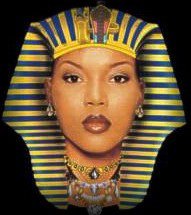 The four different covers of italian Vogue - Black Issue photographed by Steven Meisel.
The four different covers of italian Vogue - Black Issue photographed by Steven Meisel.(From Left to Right: Liya Kebede, Sessilee Lopez, Jourdan Dunn and Naomi Campbell)
And here an interview with italian Vogue editor Franca Sozzani about the Black Issue published in the New York Times. By Cathy Horyn
Q: So how did the black issue come about?
A: I was in New York in early February for the shows. I always notice the black girls in the streets in New York, more than I would in Milan. And it was also the time of the primaries, Super Tuesday. I’m interested in Obama. In the beginning Steven and I were talking about three or four stories, and then it became the entire issue. Steven really tried to reach all the girls who were around—Pat Cleveland, Iman, Naomi, the young girls, like Liya and Alek Wek. We also went back to the pictures that were used in the past of the black models and performers, like Tina Turner.
Q: Diversity on the runways has been the subject of a lot of media attention.
A: We asked Robin Givhan [of The Washington Post] to write a piece. She did a good story. She said that what we were doing was great but—what will happen next month? Will everything go back to where it was before, with all-white models? I think she was right to ask that. I hope the issue will be something that can change things. Anyway, people will talk about it, for sure. Like or dislike, it will be a controversial issue. I think it’s good to keep that tension and focus on this subject.
Q: Everybody complains about the models today, the sameness, the blank faces.
A: Nowadays, at the shows, I turn to my editors and say, ‘What’s the name of the girl, what’s her name?’ I really cannot recognize one from the other. The models in the past, like Linda and Naomi, were immediately recognizable. They had a lot of personality. These new girls have nothing. You can paint everything on their faces in a way because they have no expression. And the girls we used to see on the runway were very elegant. Liya is elegant. To me, she walks like a princess. Now the girls all look the same—from the first to the last.
The problem is partly with the modeling agencies. They have a lot of white girls—it’s easier. To find black girls takes more time. It’s a problem of research and talent, to find the right girls. We’re a little bit back to a period in the 70s, when you didn’t remember the name of a single model. They were not girls making an interpretation of the clothes, the way Linda did. They were just models. In the beginning of the 90s, those models were really celebrities—Christy, Naomi, Cindy, Stephanie.
Q: It’s the follow-the-leader mentality. And it winds up being such a narrow view of the world.
A: When you see the black issue and all the pictures, you realize that these girls in a way have to work much harder than other models. They are more in touch with their own personalities—they’re not simply models in front of a camera. They really try to get the tension.
Q: Do you think the issue will have an impact?
A: Yes, I think it will. I noticed the June issue of French Vogue had a split cover with a black model and white model, though there’s nothing inside.
Q: It’s interesting that you mentioned Obama…
A: Here in Italy, everybody is crazy about Obama, even people who never talk about American politics. It’s the new way to see a country where something can always happen. It’s a young country and modern. The feeling is similar to the Kennedys, but 50 years later. Ultimately, it’s not about race.
Q: It’s strange to be talking about racial diversity today in fashion. We should be further along. Is there a risk the fashion world will just see it as something trendy?
A: It could happen, and it would be a pity. Because, you know, it’s easier to do a normal issue. Paolo Roversi does a story, Craig McDean does another, and Steven Meisel another… I would feel very disappointed if this is only a nice moment. We should go forward.
Q: I suppose an all-black issue is something an American magazine might naturally or logically have done, more so than an Italian magazine.
A: In a way, it’s one of those stupid ideas that when everyone sees it, they think, Oh, I should have done that. [Sozzani laughs] It was so easy.
Q: What the black issue a political gesture?
A: I didn’t feel it was a political gesture. Maybe it was political in that when I see all these girls who look alike in a fashion show, they really annoy me. We need to see beautiful clothes on beautiful women.
Read Cathy Horyn’s article “Conspicuous by Their Presence” on the July issue of Italian Vogue.








